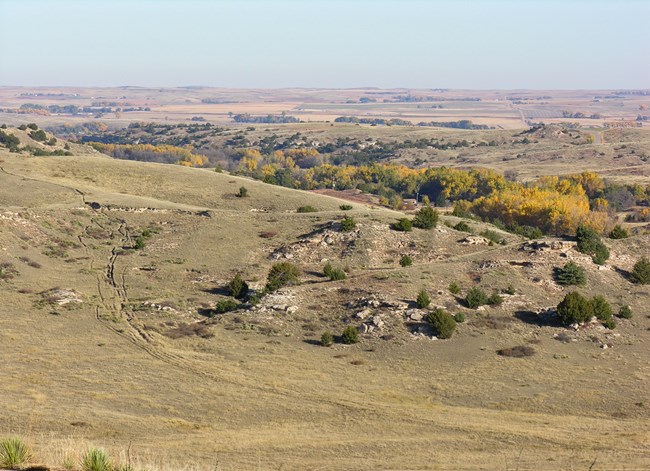Part of a series of articles titled The Emigrant Experience .
Previous: Cholera: A Trail Epidemic
Next: The Platte Experience
Article

Photo/NPS
As American settlers surged westward across the eastern woodlands and prairies in the early 19th century, they pushed American Indians out of their ancestral homes. The U.S. government resettled many of those displaced Eastern tribes —the Kickapoo, Delaware, Potawatomi, and others— in congressionally designated Indian Territory west of the Missouri River and south of the Platte. The resettled Eastern tribes were among the first Indians encountered by emigrants passing through northeastern Kansas.
Settlements for the Eastern tribes were carved out of territories already occupied by the Kanza, Otoe, Missouria, Osage, Pawnee, and other Missouri River tribes. Those groups, in turn, were forced to move, giving over their traditional hunting grounds and village sites to the Eastern groups. Their relocation often put them closer to enemies such as the Cheyenne and Sioux, powerful Indian nations that had moved out onto the Nebraska plains from their eastern woodland and prairie homelands.
The Pawnee of northern Kansas and east-central Nebraska were one of many tribes displaced by white settlement. Pawnees were settled village dwellers who lived in earth-lodges, raised garden crops, and ranged onto the plains to hunt buffalo. In 1833, they agreed in a treaty with the U.S. to surrender their weapons, give up their lands south of the Platte, and relocate their villages to make room for displaced 18 “Hunting Buffalo on the Plains” by William Henry Jackson Auto Tour Route Interpretive Guide Nebraska Eastern tribes. In return, the United States promised them protection.
The move put the Pawnees closer to territory controlled by the Lakota Sioux, their traditional enemies. In lightning attacks, Lakota fighters began systematically striking Pawnee settlements along the Loup River. The promised Army protection, if it came, was too little and too late. The Pawnees moved their villages back to the south side of the Platte to buffer them from their Plains enemies, but hostilities continued. As the Western emigrant trails opened in 1841, the Pawnee and Lakota —both fierce and eager fighters— were engaged in total warfare. At the same time, the Pawnee also battled other Missouri River tribes, such as the Kanza and Osage. In the early years of the emigration, war parties crisscrossed the wagon trails, clashed in bloody conflicts, and carried war trophies home past unnerved pioneers. While those war parties did not attack white settlers, they seemed an uneasy omen of troubles to come.
The river of white-topped wagons flowing across their lands certainly brought troubles to the tribes. Cholera, influenza, smallpox, and measles carried by sick travelers spread to American Indians along the trail. Pioneers slaughtered bison and turned out their livestock to graze on the buffalo feeding grounds, causing the great herds on which the tribes depended to retreat from the Platte Valley. As years passed, more and more emigrants left the Platte River Road to settle in Nebraska, where many hungrily eyed “empty” Indian lands. Some settlers trespassed on tribal property to steal timber and game, and others boldly built illegal homesteads on Pawnee lands north of the Platte.
These Indians have long held undisputed possession of this extensive region, and…they consider themselves entitled to compensation, not only for the right of way through their territory, but for the great and injurious destruction of the game, grass, and timber, committed by our troops and emigrants. — Luke Lea, Indian agent, 1859
Practical and shrewd, the Pawnees demanded that emigrants pay to cross their ancestral lands and use their resources. If refused fair payment, they were known to take travelers’ belongings or raid their livestock —their skill and daring in stalking emigrant herds was legendary. Pawnees could be threatening, even dangerous, when confronting white travelers, and they were blamed for a number of killings along the Nebraska trails. Many a pioneer approached Pawnee country with fear and a ready rifle.
All of the Pawnee nation are noted for their love of plundering travelers of their horses and mules, but not often anything else. — William Clayton, Mormon emigration of 1847
By the late 1850s, the friction between whites and Indians led settlers to demand that the Pawnee be removed from Nebraska Territory. Instead, in 1859 the tribe reluctantly signed away the rest of its land and moved its villages to a reservation north of the Loup River — once again on the outskirts of enemy territory. The Lakota and their allies, the Cheyenne and Arapahos, stepped up their attacks on the Pawnees’ reservation villages, striking at least eight times that year.
Pawnee, Sioux, Arapaho, Cheyenne, and emigrants all would soon collide in warfare on the Nebraska frontier.
A smothered passion for revenge agitates these Indians, perpetually fomented by the failure of food, the encircling encroachment of the white population, and the exasperating sense of decay and impending extinction with which they are surrounded. — William Bent, trader and Indian agent, 1859
This article was adapted from:
Part of a series of articles titled The Emigrant Experience .
Previous: Cholera: A Trail Epidemic
Next: The Platte Experience
Last updated: November 24, 2020